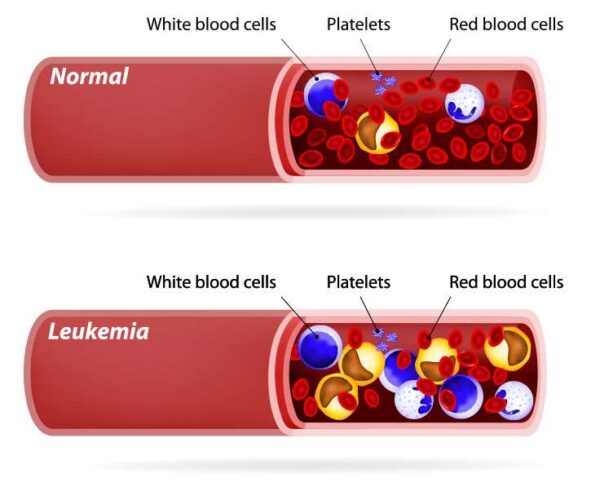Your Resources
Leukemia
Leukemia Treatment in Huntsville Alabama and Other Locations
Leukemia

Leukemia is a type of cancer that starts in blood-forming tissue. When a normal blood cell becomes damaged it dies, and the body replaces it with a healthy blood cell. Unlike normal blood cells, the leukemia cells don’t die off when they become old or damaged. This causes them to crowd out normal healthy cells which provide oxygen, control bleeding, and fight infections. All blood cells come from stem cells. There are three types of blood cells; red blood cells, platelets, and white blood cells. Leukemia can be classified as either acute, which is fast growing, or chronic, which grows at a slower rate.
Leukemia can be categorized into acute lymphocytic leukemia (ALL), acute myeloid leukemia (AML), chronic lymphocytic leukemia (CLL), chronic myelomonocytic leukemia (CMML), acute promyelocytic leukemia (APL), or chronic myeloid leukemia (CML). Symptoms of leukemia can vary depending on the type, but some of the more common symptoms associated with leukemia are below. These symptoms might not be caused by leukemia, but could be caused by another underlying health condition. Please consult your healthcare provider if you have any of the following symptoms:
- Fatigue
- Dizzy or lightheaded
- Shortness of breath
- Fever
- Infections that keep coming back
- Bruises easily
- Frequent nosebleeds or bleeding in the gums
- Night sweats
- Unexplained weight loss
- Bone pain
- Enlarged lymph nodes
- Pain or abdominal feeling of fullness
- Unexplained rash
Leukemia can be categorized into 5 different types, and each type has different risk factors. Some of the risk factors are below. For risk factors associated with a specific type of leukemia, please visit the American Cancer Society. Having a risk factor does not necessarily mean that you will get leukemia.
- Exposure to high levels of radiation
- Certain chemical exposures, such as, but not limited to, Benzene
- Certain viral infections
- Certain inherited syndromes
- Smoking
- Certain chemotherapy drugs
- Race/ethnicity
- Gender
- Having an identical twin with ALL
If your healthcare provider suspects you may have leukemia based on certain symptoms seen in a physical exam, he may run blood tests. If your blood cell count suggests that leukemia might be present, he will probably refer you to a hematologist for further testing. The hematologist may run one or more of the following tests to confirm the diagnosis:
- Blood test
- Bone marrow biopsy
- Chromosome testing
- Lumbar puncture
- Lymph node biopsy
- MRI
- CT scan
- Ultrasound
- Bone Scan
Leukemia is classified as acute or chronic depending on how fast it grows. The two types can be further categorized as lymphocytic leukemia or myelogenous leukemia. Treatment for leukemia will vary from patient to patient depending on the type of leukemia and their current health status. Once the leukemia is diagnosed and typed, a Clearview hematologist will discuss available treatment options. That treatment may involve one or more of the following:
